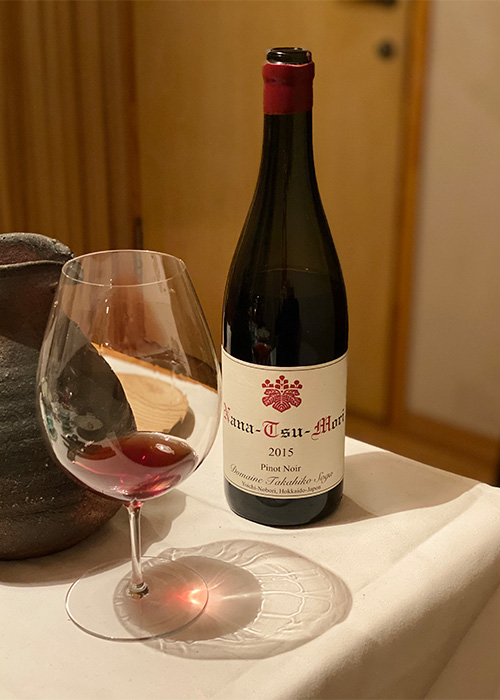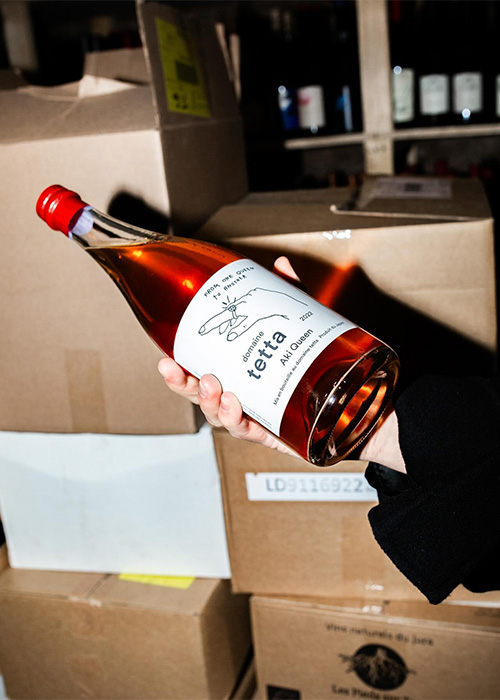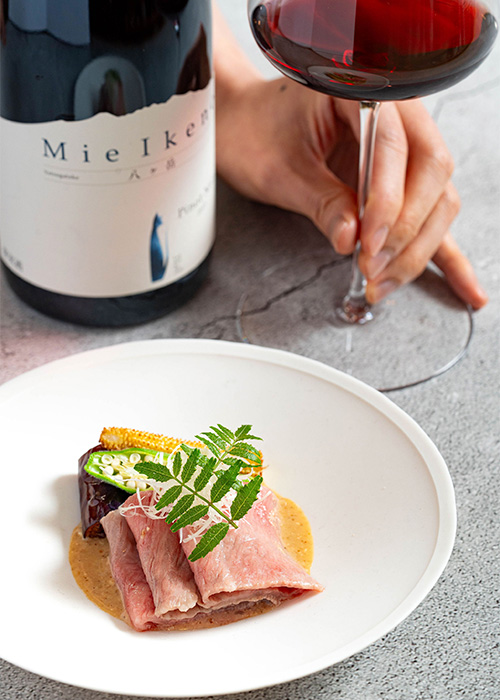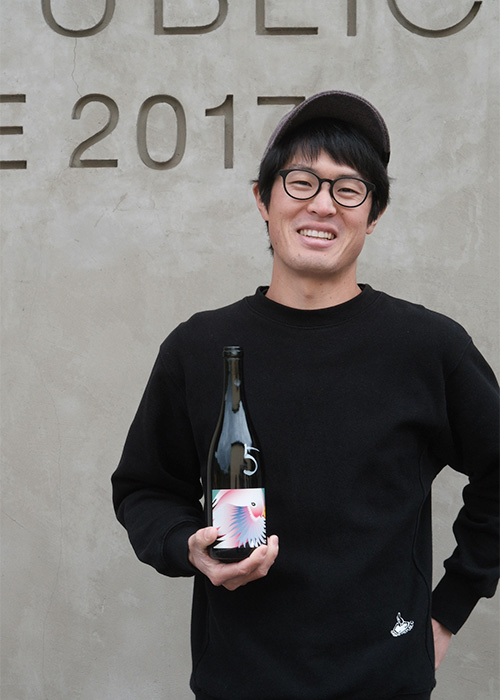


A new cult wine has grabbed the attention of American wine buyers and enthusiasts. The Pinot Noir, which first hit the U.S. market in 2022, is highly allocated, sells out almost immediately each vintage, and proves near-impossible to find. The few bottles currently available are listed at severely hiked-up prices, garnering $500 to $700 a bottle (compared to the suggested retail price of $150). This might sound like the hype that typically surrounds a top producer in Burgundy but the wine in question actually hails from Hokkaido, Japan.
From the esteemed Domaine Takahiko, this bottling is one of several Japanese wines that have landed in the U.S. in recent years, and they’re slowly making their way onto more restaurant lists and retail shop shelves across the country. Though the push for Japanese wine remains a small movement, the wine professionals behind it are eager to spread the word and continue to grow the category each year.
The wine’s compelling characteristics and aesthetically pleasing labels account for some of the appeal, but the root of this movement goes deeper than the liquid itself. Consider, for example, the general appreciation of Japanese craftsmanship that’s lent to the success of spirits like Japanese whisky and gin, not to mention products like cars. Interest from U.S. consumers also stems from Japan’s longstanding association with the natural wine movement and, more recently, a rise in tourism to the island nation. But in a market already flooded with wine from France, Italy, and Spain, as well as domestic options, why are wine pros turning their attention to this emerging wine-producing country now? As these factors coincide with increased access to Japanese wine stateside, is the category poised to make further strides in the future?
Japanese wine can be broadly categorized into two styles. There are the classic-leaning wines made from traditional French grapes like Pinot Noir, Chardonnay, and Merlot. Then there are the wines that embrace Japan’s local hybrid grape varieties, like Koshu and Muscat Bailey A., which have a long history in the country. Many producers working with these grapes embrace their distinct flavor profiles, making affordable, aromatic, juicy wines that more closely resemble a “glou-glou” natural wine. Wineries are popping up across the country — with over 450 and counting, currently — though recently there’s been a lot of interest from producers and consumers in the potential of Hokkaido and the Yamanashi prefecture as premier regions.
While Japanese wine was virtually nonexistent in America pre-2020, a surge of importers started bringing in bottles after the pandemic, and the pace of new Japanese wines hitting the U.S. market has only accelerated since. D-I Wine started in 2021 with a small order from Domaine Tetta, Jose Pastor Selections brought in its first batch from Domaine Takahiko in 2022, natural wine maverick Zev Rovine also dipped his toe into the category in 2022 with Grape Republic, and Skurnik created a Japanese wine portfolio in 2024 with legendary producers Domaine Mie Ikeno and Katsunuma Winery.

Though it’s not widely known as a winemaking nation, Japan has established itself as an authority among industry insiders. Tokyo is often credited as one of the earliest adaptors of the global natural wine movement, with iconic wine bars like Ahiru Store leading the way. Since these hubs would often secure rare, hard-to-find French wines from trendy regions — there’s even a bar that exclusively sells wines from the Jura — Tokyo quickly became a destination for wine pros to seek out buzzy bottles.
“Japan was one of the first countries to embrace natural wine outside of France. In fact, there’s even a rumor that the term ‘natural wine’ was first coined in Japan 20-plus years ago,” says Rui Maekawa, the New York-based founder of Japanese wine and liqueur sourcing company Kind Wine.
Jamie Graves, the Japan portfolio manager for Skurnik, also believes there’s a connection between Japan’s booming bar and restaurant scene and the uptick in wine production and interest in Japanese wine. “It really came out of the fact that Japan has a couple of generations of wine professionals now,” he says. “When the economy improved a lot in the ‘80s, there were a lot of restaurants in Tokyo with long wine lists, and a lot more people working with wine more closely.”
There are also a number of Japanese winemakers behind some of France’s most sought-after bottlings, including Kenjiro Kagami of Domaine des Miroirs and Rié and Hirofumi Shoji of Pedres Blanques, which helped bring the concept of Japanese winemaking and craftsmanship to the forefront for wine geeks.
“When I started working at Sushi Noz last year, there was no Japanese wine section on the list and now we might have the biggest Japanese wine selection in NYC.”
Japan’s deep association with wine culture brought the country into the orbit of many U.S. wine professionals. When Brett Taylor started the boutique import company D-I Wine in 2019, he often looked to Tokyo’s natural wine scene for inspiration.
“Building our portfolio we were trying to think outside the box of classic wine regions. We looked all over the world — Brazil, South Korea, China, Colorado — places you’d never associate with wine,” Taylor says. “With Japan there was another aspect that drew us in: We started following a bunch of different wine shops and restaurants online, and they always had the coolest wines that we had never seen before, like emerging producers from France that hadn’t been discovered by New York importers.”

Following the cookie crumb trail of niche French wines, Taylor started to notice that the trendy Tokyo shops also carried Japanese wines. Intrigued, he started messaging producers. After a flurry of translator-mediated Zoom calls and logistical shipping nightmares, D-I Wine finally brought in its first small order from Domaine Tetta. The wines immediately won over U.S. drinkers with their playful labels and bright, quaffable profile. After seeing so much demand, Taylor decided to go all in, and just launched a full Japanese wine portfolio, complete with six new producers that arrived in the U.S. in early 2025.
Now that there’s broader access to Japanese wine in the U.S., wine pros are tasked with finding a niche for it to fill in the already saturated (and struggling) wine market. So far, the wines have taken a foothold in two major outlets: Japanese restaurants and natural wine haunts.
When Tsukimi, a Michelin-starred kaiseki counter in New York City’s East Village first opened in 2019, Japanese wine was hard to come by. General manager Karen Lin and head sommelier Shiho Tanaka were both eager to offer a pairing with the restaurant’s tasting menu, and recall they only started to see them arrive in 2022. The restaurant finally accumulated enough Japanese wine to launch an eight-course pairing menu featuring exclusively Japanese winemakers in 2024.
Customers can order some of these wines by the bottle, but Lin and Tanaka reserve the majority exclusively for the pairing, not only because they’re only available in extremely limited quantities, but also as a way to introduce more guests to the category and bring more exposure to the concept. Throughout the tasting, Lin and Tanaka present each wine in detail, sharing information on Japan’s grapes and regions as well as its brightest up-and-coming producers.

Similarly, when sommelier Tira Johnson took over as the beverage director of We All Gotta Eat — the hospitality group behind two-Michelin-starred omakase restaurant Sushi Noz — in mid-2024, she made it a priority to showcase these wines.
“Much like Japanese whisky, the meticulous dedication to quality builds trust in Japanese wine as well.”
“I’ve had a big interest in Japanese wine since 2021 when I first discovered it and my passion continues to grow year after year,” she says. “When I started working at Sushi Noz last year, there was no Japanese wine section on the list and now we might have the biggest Japanese wine selection in NYC.” The lineup features wines from the northern island of Hokkaido and Yamanashi right outside of Tokyo, including a vertical of Mie Ikeno’s coveted Chardonnays, Pinot Noirs, and Merlots.
Johnson stresses that these wines aren’t only meant to be paired with Japanese cuisine. At the restaurant group’s latest opening, Chez Fifi, an upscale French bistrot on the Upper East Side, she suggests Lumiere’s barrel-aged Koshu to complement the roast chicken with foie gras jus.
Influential sommelier Pascaline Lepeltier has also long been a proponent of Japanese wines, offering a dedicated “Japan” menu section on the list at Chambers since it opened in 2022. (Lin recalls a guest who came into Tsukimi looking for Japanese wine saying he had first tried it at Chambers.)
But these wines don’t only thrive in NYC’s fine-dining establishments. The more approachable, natural-leaning examples from producers like Domaine Tetta and Grape Republic also find success at boutique wine shops and bars across the country. Spots like Sauvage in Phoenix, The Buzzed Word in Ocean City, Md., m4 Wine in Michigan, Bin Bin Sake in Brooklyn, and Petite Bottle Shop in Seattle eagerly await their small allotments from these producers each year. And natural wine bars with thoughtful lists like With Others in Brooklyn and Philadelphia’s Picnic also make a point of featuring these wines whenever they can get their hands on them.
Even with placements at top restaurants and shops, what might convince someone to order a Japanese wine over a French wine — especially at price points that rival those of heavy hitters from Burgundy?
So far, their distinct qualities and esoteric nature have made them appealing to two of wine’s biggest groups: collectors who covet extremely rare and expensive bottlings, and natural wine fanatics who are always looking for the next new thing.

Plus, tourism to Japan reached new heights in 2024. As the yen’s status made the trip financially favorable for U.S. visitors, more people than ever hopped on a plane to indulge in fatty tuna and 7-Eleven egg salad sandos. And as Americans continue to develop a love for all things Japan after visiting, the demand is sure to rise further.
The willingness to pay a premium for wine from Japan isn’t all that surprising, considering the trajectory of Japanese whisky, a category that catapulted from obscurity to include some of the world’s most expensive, sought-after bottles. Maekawa of Kind Wine attributes this to the culture’s known value of craftsmanship: “Much like Japanese whisky, the meticulous dedication to quality builds trust in Japanese wine as well,” she says.
With inflated prices and competitive allocations, it’s easy to see how Japanese wine can follow the path to prominence that the country’s whisky experienced before it. Coming off of the hit success of Domaine Tetta’s wines, Taylor is motivated to expand D-I Wines’ Japanese offerings further, and sees a bright future for the category. “I don’t think these wineries are going anywhere, I think there’s going to be more and the quality is going to improve,” he says. “And we’re actively focused on bringing more in. We’re making appointments, tasting samples, and looking to double, triple, quadruple our numbers.”
The article Can Japan Replicate What it Did for Whisky With Wine? appeared first on VinePair.